Enterprise AI Implementation Guide for Context Engineering
Enterprise organizations face a unique challenge with AI implementation. While startups can experiment freely, enterprises must integrate AI into existing systems, comply with security requirements, and justify every technology investment. The good news? Effective context engineering for enterprise AI doesn’t require ripping out your current infrastructure. In fact, your existing tools might be more powerful than the latest AI platforms.
The Enterprise AI Integration Challenge
When enterprises consider AI implementation, vendors pitch comprehensive platforms that promise to revolutionize operations. These solutions often require significant infrastructure changes, new security protocols, and extensive training. But there’s a fundamental misunderstanding here about what makes AI effective in enterprise environments.
The real challenge isn’t adopting new AI platforms. It’s providing AI models with the right context from your existing systems. Most enterprises already have decades of tools and processes that manage information effectively. The key is leveraging these existing assets for AI context engineering rather than starting from scratch. Understanding practical AI implementation strategies becomes crucial for enterprises looking to maximize their existing technology investments.
Why Enterprise Tools Excel at Context Engineering
Large organizations have spent years refining their toolchains. Version control systems track every code change. Database systems manage terabytes of structured information. Monitoring tools capture system behavior. Documentation platforms store institutional knowledge. These aren’t just legacy systems; they’re sophisticated context providers.
When you approach enterprise AI implementation through context engineering, these existing tools become assets rather than obstacles. A version control system that’s been customized for your workflows can provide better context than any generic AI platform. Your database interfaces, refined through years of use, already know how to surface relevant information efficiently.
Security-First Context Engineering
Enterprise AI implementation must prioritize security, and this is where existing tools shine. Your current systems already comply with security policies, have established access controls, and integrate with identity management. Building new AI platforms means recreating all these security measures from scratch.
By using established tools for context engineering, enterprises maintain security compliance naturally. The AI accesses information through the same secure channels your developers already use. There’s no need to create new attack surfaces or worry about data leaving approved systems. This approach turns security from an AI implementation barrier into an advantage.
Scaling AI Across the Enterprise
One of the biggest challenges in enterprise AI implementation is scaling beyond pilot projects. Many organizations successfully deploy AI in one department but struggle to expand enterprise-wide. The problem often lies in trying to replicate complex custom solutions across different teams with different needs.
Context engineering through existing tools solves this scaling challenge. Every department already uses version control, databases, and documentation systems. By teaching teams to leverage these tools for AI context, you create a scalable approach that adapts to each team’s specific workflows while maintaining consistency in the overall strategy. This approach aligns with proven AI system design patterns for scalable applications that prioritize modularity and reusability.
The ROI of Infrastructure Reuse
Enterprise executives need clear ROI justification for AI investments. Building new AI platforms requires significant capital expenditure with uncertain returns. But context engineering through existing tools offers immediate, measurable benefits with minimal additional investment.
The ROI comes from multiple sources: reduced infrastructure costs, faster deployment times, lower training requirements, and decreased security risks. More importantly, you’re enhancing tools your teams already use daily, ensuring adoption and value realization. This approach transforms AI from a risky investment into a logical enhancement of existing capabilities.
Building Enterprise AI Capabilities Incrementally
Unlike startups that can pivot quickly, enterprises must manage change carefully. Context engineering enables incremental AI adoption that doesn’t disrupt operations. Teams can start by using AI with their current tools in low-risk scenarios, building confidence and expertise gradually.
This incremental approach also allows for learning and adjustment. As teams discover what context enables the best AI performance, they can refine their practices without major system changes. Success in one area becomes a template for expansion, creating organic growth of AI capabilities across the enterprise.
The Competitive Advantage of Mature Infrastructure
While competitors chase the latest AI platforms, enterprises that master context engineering with existing tools gain a sustainable advantage. Your decades of refined processes, customized tools, and institutional knowledge become differentiators when properly leveraged for AI.
This advantage compounds over time. As your teams become more skilled at providing context through familiar tools, AI effectiveness improves. Meanwhile, competitors struggling with new platforms face adoption challenges, security concerns, and integration complexity. The enterprise that moves fast by moving smart wins the AI race.
To see practical examples of enterprise context engineering using existing tools, watch the full video tutorial on YouTube. I demonstrate how mature development tools provide better AI context than complex new systems. Ready to implement AI in your enterprise effectively? Join the AI Engineering community where we focus on practical, enterprise-ready AI strategies that leverage your existing investments.

